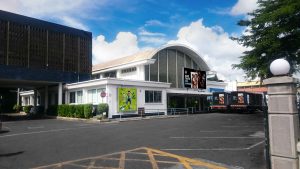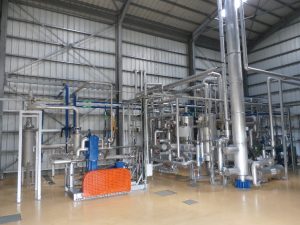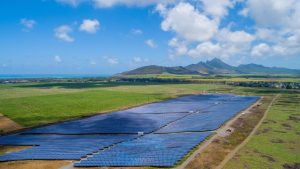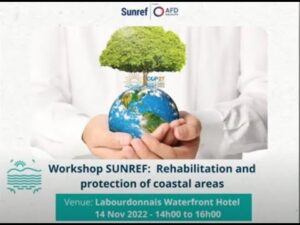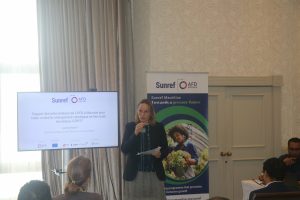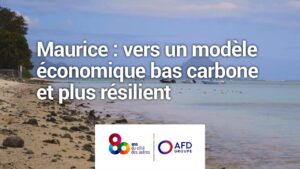What is SUNREF?
A green credit line for businesses and individuals, through partner banks and local technical assistance
Developed by Agence française de développement (AFD) in more than 30 countries, Sustainable Use of Natural Resources and Energy Finance (SUNREF) is part of a broad initiative to promote energy efficiency and renewable energy, as well as the sustainable use of natural resources in priority sectors, namely: Construction, Hospitality, Manufacturing and Agriculture. In partnership with the Mauritius Commercial Bank Ltd (MCB), SBM Bank (Mauritius) Ltd (SBM), and AfrAsia Bank Limited (ABL), SUNREF Mauritius offers both financial and technical assistance, so that companies can seize the opportunities of green growth, increase their competitiveness, improve their brand image and get access to new markets.
AFD’s green finance label
SUNREF Mauritius consists of a credit line of EUR 85 million provided by the AFD through partner banks to finance green and inclusive projects which can benefit from Investment Grants of between 5% and 16% of the eligible loan amount. AFD has been involved since 2009 in assisting Mauritius in its transition towards a greener, more inclusive, and more sustainable economy. In association with three local partner banks, AFD has successfully developed a green finance market with appropriate marketing approaches.
SUNREF Mauritius also has a technical assistance programme to help:
- Build the technical capacity of partner banks to identify investment opportunities in climate change mitigation and adaptation, as well as in gender equality
- Advise investors on the eligibility of their investment under the SUNREF Mauritius programme and propose best in class technologies, as they develop their projects
- Monitor the implementation of their projects
- The banks market, communicate and promote the financial offers available under the credit line
Topics covered by SUNREF Mauritius: Mitigation & Adaptation to climate change as well as Gender equality
Eligible investments
The below list is non-exhaustive and proposes investments that are eligible under the 3 main components of the SUNREF programme:
- Climate change mitigation
– Investments in renewable energies (for example: Solar PV, wind, hydro, biomass)
– Investments in energy efficiency projects.
– Investments in electric mobility.
– Financing of eco-businesses (for example: producers/installers of solar water heaters or Energy Saving Companies (ESCOs))
– Investments in green buildings with resilient solutions (with regards to treatment on water management, resilience against strong winds, risk of flooding, extreme temperatures, etc…). - Climate change adaptation
– Investments in water resource management (irrigation, recycling, rainwater harvesting, desalination plant)
– Investments in smart agriculture projects (for example: sheltered farming, resilient varieties, use of technology, etc…)
– Investments geared towards coastal zone protection & rehabilitation
– Investments related to thermal insulation (using bio/plant based materials, green roofs, etc…)
– Investments related to treatment of wastewater & effluents
– Investments in green buildings with resilient solutions (with regards to treatment on water management, resilience against strong winds, risk of flooding, extreme temperatures, etc…).
– Certified green buildings are eligible under Mitigation and/or Adaptation (case by case treatment to identify the nature of the certification and the solutions implemented). - Gender
– Investments based on the action plan delivered after the gender self-assessment for which technical assistance is available to provide support.
List of Eligible Materials and Equipment (LEME)
This pre-established list provides a precise description of the eligible technologies for climate change mitigation and adaptation projects.
| wdt_ID | No. Ref | Best Available Technology (BAT) | Objective | Applications | Minimum Performance Criteria / Minimum requirements | Download | Links |
|---|---|---|---|---|---|---|---|
| 1 | A | Water resource management | |||||
| 2 | A.1 | Rainwater collection for domestic use | |||||
| 3 | A.1.2 | Water tank | Reduce consumption of drinking water for non-drinking purposes | Install to collect rainwater from the roof and gutters | Decrease of overall water consumption (10% minimum) or % of non-potable use provided by collected water (20% minimum) | Links | |
| 4 | A.2 | Water runoff collection | |||||
| 5 | A.2.1 | Retention basin | Collect runoff water for local non-drinking usage instead of resorting to utility facilities | Underground structure of runoff water with regulated drainage system under green areas, sports field, or for smaller volumes at private homes | Decrease of overall water consumption (10% minimum) or % of non-potable use provided by collected water (20% minimum) | Links | |
| 6 | B | Water demand management | |||||
| 7 | B.4 | CIP (Cleaning In Place) | |||||
| 8 | B.4.1 | CIP (Cleaning In Place) with recirculation process | The CIP is an autonomic system for installation cleaning without proceeding to dismantling all the equipment | Industrial Use: beverage industry, agrofood industries, dairy product activities | Decrease of water consumption by 70% in relation with cleaning processes and chemical reagent consumption by at least 40%, from return of experiences (technical littérature) when recirculation configuration is implemented | Links | |
| 9 | B.3 | Techniques de réutilisation des effluents traitées | |||||
| 10 | B.3.1 | Microstation, with tertiary treatment | Used treated effluent for irrigation purposes. Reduction of potable water consumption | Domestic used and industrial use | Mauritius standards for reused in irrigation + supplier performance (on technical specifications) | Links | |
| 11 | B.2 | Techniques for improving water efficiency for agricultural / landscape use (including water-saving irrigation techniques) | |||||
| 12 | B.2.1 | Micro-irrigation or drip irrigation | Water the plantations as close as possible. Limit water losses by evaporation, splashing, …) | Drip irrigation with subsurface pipes | Decrease of overall water consumption (10% minimum) or % of non-potable use provided by collected water (20% minimum) | Links | |
| 13 | B.2.2 | Lateral move irrigation system | Limit water losses | Sugar cane application and large exploitation | Decrease of overall water consumption (10% minimum) or % of non-potable use provided by collected water (20% minimum) | Links | |
| 14 | B.1 | Technologies for improving water efficiency (domestic use) | |||||
| 15 | B.1.1 | Tap Aerator | Reduce potable water consumption | Installed on each tap (domestic and industrial used) | Decrease of water consumption (30% minimum) | Links | |
| 16 | B.1.10 | Water-saving washing machine | Reduce potable water consumption | Use washing machine with water reduction | Energy efficiency Min Class A ++ Average water consumption per cycle less than or equal to 60L | Links | |
| 17 | B.1.2 | Efficient Shower | Reduce potable water consumption | Installed on each shower (domestic and industrial used) | Decrease of water consumption (30% minimum) | Links | |
| 18 | B.1.3 | Water savers for WC tank | Reduce potable water consumption | Installed on each toilet (domestic and industrial used) | Decrease of water consumption (30% minimum) | Links | |
| 19 | B.1.4 | Rainwater system to provide flushing water to the toilet | Reduce potable water consumption | Implement for new construction (private ou industrial) | Decrease of water consumption (30% minimum) | Links | |
| 20 | B.1.5 | Timed Tap | Reduce potable water consumption | Implement for new construction (private ou industrial) | Decrease of water consumption (30% minimum) | Links | |
| 21 | B.1.6 | Limited flow systems (flanges) | Reduce potable water consumption | Implement for new construction (private ou industrial) | Decrease of water consumption (30% minimum) | Links | |
| 22 | B.1.7 | Double Stop Mixers (sinks) | Reduce potable water consumption | Implement for new construction (private ou industrial) | Decrease of water consumption (30% minimum) | Links | |
| 23 | B.1.8 | Thermostatic mixing valves (showers) | Reduce potable water consumption | Implement for new construction (private ou industrial) | Decrease of water consumption (30% minimum) | Links | |
| 24 | B.1.9 | Water-saving dishwasher models | Reduce potable water consumption | To be installed on each tap (domestic and industrial used) | To be installed on each tap (domestic and industrial used) | Links | |
| 25 | C | ||||||
| 26 | C.1 | Protected crops | |||||
| 27 | C.3.1 | Defense techniques (windbreaker, nets, etc.) | High reduction of water consumption and capacity building towards a resilient crop production system | Crop cultivation / SmartAgri | Links | ||
| 28 | C.3.3 | Tunnel greenhouse | High reduction of water consumption and capacity building towards a resilient crop production system | Crop cultivation / SmartAgri | 4.35m ridge height 2.4m front beam height | Links | |
| 29 | C.3.4 | Tropic greenhouse | High reduction of water consumption and capacity building towards a resilient crop production system | Crop cultivation / SmartAgri | Crop cultivation / SmartAgri | Links | |
| 30 | C.3.5 | Classic greenhouse | High reduction of water consumption and capacity building towards a resilient crop production system | Crop cultivation / SmartAgri | Crop cultivation / SmartAgri | Links | |
| 31 | C.3.6 | Flat Net house | High reduction of water consumption and capacity building towards a resilient crop production system | Crop cultivation / SmartAgri | roof height 4.0m No trellising support | Links | |
| 32 | C.3.7 | Total Net house | High reduction of water consumption and capacity building towards a resilient crop production system | Crop cultivation / SmartAgri | roof height 5.1m Trellising support | Links |
| wdt_ID | No Ref. | Best Available Technology (BAT) | Objective |
|---|---|---|---|
| 1 | A | Improve thermal performances of building enveloppe | |
| 2 | A.1 | Roofs and walls: retrofiting or new building | |
| 3 | A.1.1 | Insulated metal Panels Polyurethane / polycyanurate foam , Extruded polystyrene, Glass wool | Improvment of roof and wall insulation on open framing structures |
| 4 | A.1.2 | Extruded or expanded polystyrene panels, polyurethane panels, spray polyurethane foam , glass wool, rock wool panels or rolls | Improvement of roof insulation on concrete flat roofs and walls |
| 5 | A.2.2 | Adhesive film sticked on existing windows for reducing the heat transfer in the buildinga | Reduction of thermal transfert through windows |
| 6 | A.2.3 | External Shading devices : blinds, window covers , Horizontal or vertical sun protections in facade | Protection against direct sunshine (panels or other protecxtion devices) |
| 7 | A.2 | Windows | |
| 8 | A.2.1 | Double-glazing window with low SHGC glass | Improvement of thermal transfert through windows |
| 9 | A.2.2 | Adhesive film sticked on existing windows for reducing the heat transfer in the buildinga | Reduction of thermal transfert through windows |
| 10 | A.2.3 | External Shading devices : blinds, window covers , Horizontal or vertical sun protections in facade | Protection against direct sunshine (panels or other protecxtion devices) |
| 11 | B | Improve HVAC & Refrigeration System performances | |
| 12 | B.6 | Air handling units | |
| 13 | B.6.1 | High efficiency air handling unit (AHU) | Reducing electricity consumption by replacing existing AHU |
| 14 | B.6.2 | Air handling unit with cold recovery | Reducing electricity consumption by replacing existing AHU |
| 15 | B.3 | Efficient refrigeration systems | |
| 16 | B.3.1 | Air cooled high efficiency chillers | Reduce electricity consumption of chillers and pumps by replacing existing air cooled or water cooled chillers |
| 17 | B.3.2 | Water cooled high efficiency chillers. And water cooled chillers to achieve higher SEER (in Port bassins for example, at rather low depths) | Reduce electricity consumption of chillers and pumps by replacing existing air cooled or water cooled chillers by more efficient systems in termes of EER) |
| 18 | B.3.3 | Absorption/adsorption refrigeration Systems considering their high cost of investments (case by case demo projects) and their expected EER | Replace existing water cooled chiller ,to benefit from free energy produced by waste in industrial process or solar heating panels. As far as solar energy conversion is concerned, the EER should be achievable at the required levels through demo projects. |
| 19 | B.1 | Individual and medium sacae air conditionning systems up to 100 kW | |
| 20 | B.1.1 | Monosplit air cooled with inverter P cooling <20 KW. Monosplit cooling power for households should be under 5,0 kW/unit | Reduce the electric consumption by replacing ” no inverter” air conditioners |
| 21 | B.1.2 | Multisplits air cooled with inverters and with an unique external unit up to 100 kW | Reduce the electric consumption by replacing air-conditioners in the configuration of several monosplit units in the same building) with the inverter design. By a different design (only one outdoor equipment) |
| 22 | B.4 | Large range air conditionning systems – cooling towers and Advanced cooling systems | |
| 23 | B.4.1 | High efficiency dry cooling tower with high efficiency fans and motors, VSD | Reduce electricity consumption by replacing existing dry cooling tower |
| 24 | B.4.2 | High efficiency evaporative cooling tower , mini IE2 fan motors and VSD | High efficiency evaporative cooling tower , mini IE2 fan motors and VSD |
| 25 | B.4.3 | High efficiency evaporative cooling tower with hybrid condenser , mini IE2 fan motors and VSD | Reduce electricity consumption by replacing existing dry cooling or evaporative tower |
| 26 | B.4.4 | Alternative cooling systems for large scale buildings (commercial malls), agrofood industries and commercial logistics. Choice of refrigerants according to Greenhouse impacts and energy efficiency targets | Using refirgerants like the R448a in cooling systems or the NH3 and CO2 refrigerants (natural fluids) to reduce energy consumption by 20% and have a reduced Global Warming Power (ratio: GWP level). Selection criteria refer to comments. |
| 27 | B.2 | Medium range air conditionning systems above 100 kW | |
| 28 | B.2.1 | Variable refrigerant flow (VRF) ou variable refrigerant volume (VRV) units above 100 KW | Reduce the electric consumption by replacing existing monosplit, multisplit or small chilled water-air conditioned systems. The design is either under the ” variable refrigerant flow or variable refrigerant volume” VRF ou VRV concept for systems above 1 |
| 29 | B.5 | Pumping equipements | |
| 30 | B.5.1 | High efficiency pump (Motor and pump integrated or non integrated) | Replace electricity consumption bu replacing existing pump |
| 31 | B.7 | Water chilled water storage (Thermal storage) system | |
| 32 | B.7.1 | Cold chilled water storage (thermal storage) systems include regulation devices, supervision equipements…) to have high performance ratio | Store energy produced as free energy at a low cost to postpone its use during the peak hours (peak demand) |
| 33 | C | Reduce energy consumption to produce hot water | |
| 34 | C.2 | Heat recovery | |
| 35 | C.2.1 | Heat recovery exchanger on chiller condensers. | Recover heat from hot gases before chiller condenser to produce hot water for sanitary or industrial uses |
| 36 | C.2.2 | Heat recovery on air compressor | Recover heat from hot compressed air to produce hot water for sanitary use |
| 37 | C.1 | Solar water heaters | |
| 38 | C.1.1 | Vacuum tube collectors | Produce hot water from solar energy for sanitary or industrial uses |
| 39 | C.1.2 | Flat plate collectors | Flat plate collectors |
| 40 | C.1.3 | Heat pumps for the production of hot water for households or large scale facilities within the residential sector or hotels | Heat Pumps: producing hot water of households or large scale facilities with high SEER above 4, leading to high electricity efficiency and avoiding constraints linked to large roof surface needed for thermal solar panels |
| 41 | D | Improve lighting system efficiency | |
| 42 | D.1 | Lamps, fixtures and ballasts | |
| 43 | D.1.1 | Led lamps: led downlight fixtures. | Replace lamps and fixtures existing lamps by more efficient and sustainable led equipped devices. |
| 44 | D.1.2 | Connected supervision (web) of street lighting systems using LED lamps with real time monitoring | Electricity savings through low energy consumption strategies with LED (lamps) and connected monitoring devices to adapt the lightling power in real time for the best service |
| 45 | E.1.3 | Window air Conditioning shut-off Switch | Automatic stop of functioning of air conditioning when windows are opened |
| 46 | E | Reduce electricity consumption by monitoring and Control System implementation | |
| 47 | E.1 | Lighting , HVAC control system and Advanced Cooling systems | |
| 48 | E.1.1 | Occupancy sensors | Reduce lighting and air conditionning consumption by implementing occupancy control systems |
| 49 | E.1.2 | Energy saving switch for hotel | Reduce the electric consumption by automatic cut of the supply of the main electrical devices |
| 50 | E.1.4 | DALI (Digital adressable lighting interface) | Decrease of electricity consumption of electricity by an optimized management of lighting |
| 51 | E.1.5 | Building management system associated with data collection | Computerized data collection of energy consumption parameters such as flows, electric power, temperatures, pressure in ordrer to manage anf optimize lighting, HVAC and Cooling systems |
| 52 | F | Improve energy efficiency of electrical motors and promote renewale energy solutions (PV systems and solar pumps) | |
| 53 | F.1 | Electric motors | |
| 54 | F.1.1 | High efficiency low voltage motors | Replace existing motors by efficient motor |
| 55 | F.1.2 | Variable Speed drive for AC induction motors 0,5 kW- 1 MW range | Add Variable speed drive to an existing motor |
| 56 | F.1.3 | Variable speed drive for Synchronous motors 0,75kW- 500 Kw | Add Variable speed drive to an existing motor |
| 57 | F.2 | PV Solar Systems | |
| 58 | F 2.2 | PV tracker for small/medium scale projects didn’t prove to be beneficial for large projects (benefits/ costs ratio and return of investments) | Small or medium scale if increased energy efficiency is matching overcosts of investments |
| 59 | F.2.1 | Photovoltaïc Systems with mono/polycrystalline PV panels, thin film panels, inverters, EMS or energy management systems | PV plants on roofs or ground |
| 60 | F.2.3 | High efficiency Solar Pump | Pumps with PV direct drive |
| 61 | G | Improve performance of Compressed air system | |
| 62 | G.2 | Compressed air dryers | |
| 63 | G.2.1 | Cycling Refrigerated air dryer or VSD compressor air dryer | Replace air dryer by high efficiency equipment |
| 64 | G.2.2 | Absorption air dryer | Replace air dryer in case of high quality and low volumes |
| 65 | G.1 | Compressors | |
| 66 | G.1.1 | High efficiency Screw Air Compressor | Replace reciprocating air compressor |
| 67 | H | Improve performance of steam production and steam network | |
| 68 | H.1 | Boilers | |
| 69 | H.1.1 | High efficiency steam boiler | In case of new equipment or boiler house retrofit |
| 70 | H.1.3 | Condensate recovery system | Recycle condensate in boiler to recover heat. |
| 71 | H.2 | Burners | |
| 72 | H.2.1 | High efficiency forced draught type burner | As a replacement of classic ventelle burner |
| 73 | H.2.2 | Oil burner manual or testing kit | To allow a better regulation of burners and an improvement of the burner efficiency |
| 74 | H.3 | Insulation for plumbing and equipment | |
| 75 | H.3.1 | Removable insulating pads or valves and fittings | To reduce heat losses of the steam network |
| 76 | H.3.2 | Fiberglass or foam glass pipe and fitting insulation | To reduce heat losses of the steam network |
| 77 | I | General process equipments | |
| 78 | I.1 | Fan | |
| 79 | I.1.1 | High efficiency fan | Replace or retrofit of fans on industrial installations or HVAC |
| 80 | I.3 | Heat pump | |
| 81 | I.3.1 | High efficient heat pump | Production of hot water for sanitary or industrial use |
| 82 | I.2 | Pump | |
| 83 | I.2.1 | High efficiency pump | Replace or retrofit of pumps on industrial installations or HVAC |
| 84 | I.4 | Sensors and metering | |
| 85 | I.4.1 | Pressure, Temperature, Humidity, Mass flow rate, power, lumens. These sensors will be used for data collection and energy performance contracting | Optimization of the energy use of equipments for monitoring objectives in the frame of energy performance schemes or energy management approaches |
| 86 | J | Specific Process equipments | |
| 87 | J.1 | Coolrooms, refrigerated showcases and display cabinets | |
| 88 | J.1.1 | High efficiency coolrooms, refrigerated showcases and display cabinets | Reduction of electricity consumption by more efficient new equipements |
| 89 | J.1.2 | Reinforced wall and roof insulation | Reduction of electricity consumption by retrofit of equipements |
| 90 | J.1.3 | Night blinds | Reduction of electricity consumption by retrofit of equipements |
| 91 | K | Renewable Energy: hydroelectricity | |
| 92 | K.1 | Micro / pico- hydroelectricity | |
| 93 | K.1.1 | Hydroelectric turbine Power of a few KW (pico) or up to 100 kW generators, alternators, EMS (energy management systems) | Increase of the production by retrofit or replacement of equipments |
| 94 | L | Urban Street furniture and PV systems for new services | |
| 95 | L.1 | Urban Street furniture and PV systems for new services | |
| 96 | L.1.1 | Sustainable street furniture web-connected and with PV powered associated to battery storage | Provide new neigborhood services with PV powered urban furniture not connected to the grid (E-Tree concept) |
| 97 | M | E- Mobility solutions for companies, transport operators and leasing companies | |
| 98 | M.1 | E- Mobility solutions for companies, transport operators and leasing companies | |
| 99 | M.1.1 | E-Mobility developed by companies and transport operators | Introduce E-mobility solutions for large scale applications excluding households |
With the financial participation of

Delegation of the European Union to the Republic of Mauritius
In partnership with

The Mauritius Commercial Bank Ltd




